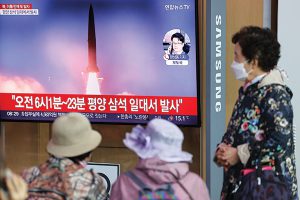Bloomberg
North Korea’s latest barrage of missiles may look like another attempt to ratchet up hostilities in return for some sort of leverage at the bargaining table. But the launches over the past two weeks seem different.
Unlike previous provocations, his regime has mostly refrained from trumpeting the missiles along with the usual creative vitriol directed at the US and its allies. Kim Jong Un himself has been out of the public eye for more than three weeks, his longest absence in a year. State media on Thursday released a photo of a floral arrangement given to Kim, but no pictures of him.
That could always indicate Kim is facing some health problems, or just taking a break. In August, his sister revealed that Kim was “seriously ill†after suffering from “high fever†during a Covid outbreak.
But more broadly, the subdued posture suggests North Korea is intent on letting actions speak louder than words as it looks to build a credible nuclear threat. And a big reason is because Kim has more reliable partners in China and Russia, which supported sanctions against his regime at the United Nations only five years ago.
That raises the prospect for greater escalation in the coming weeks and months. The US, Japan and South Korea have already warned that Kim’s regime is readying its first atomic detonation since 2017, a test that could help North Korea miniaturize warheads for new short-range missiles it has rolled out in the past few years.
“North Korea clearly has decided that the US-Russia and US-China divide works to its advantage economically and politically and, for now at least, has decided to cast its lot with the Russians and the Chinese rather than pursuing diplomacy with the US,†said Rachel Minyoung Lee, a regional issues manager at the Vienna-based Open Nuclear Network who worked as an analyst for the CIA’s Open Source Enterprise for almost two decades.
“The current vicious cycle will not end anytime soon,†she added. “North Korea is not interested in talks right now, and the US and South Korea will not make the kind of concessions that might entice Pyongyang back to the talks table.â€
North Korea has fired 10 ballistic missiles in less than two weeks, including two on Thursday toward waters where the USS Ronald Reagan aircraft carrier group had been deployed that were accompanied by a two-sentence Foreign Ministry statement— brief by Pyongyang standards.
The launches have corresponded with the carrier group’s movements around the Korean Peninsula starting in late September. The Ronald Reagan had returned to the region after North Korea on Tuesday fired its first missile over Japan in five years.
While North Korea has a habit of timing provocations with political events, the latest missiles have shown more focus than at almost any other time during Kim’s decade in power. For instance, North Korea fired two short-range ballistic missiles last month just hours after US Vice President Kamala Harris visited the Demilitarized Zone that divides the two Koreas.
What’s more, North Korea’s weapons are much better than in 2017, when soaring tensions prompted Donald Trump to warn Kim of “fire and fury†in response. His regime has modernized its arsenal with missiles that are quicker to deploy and more accurate.
 The Gulf Time Newspaper One of the finest business newspapers in the UAE brought to you by our professional writers and editors.
The Gulf Time Newspaper One of the finest business newspapers in the UAE brought to you by our professional writers and editors.
